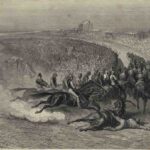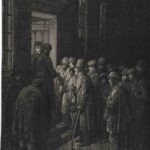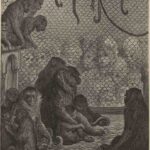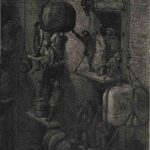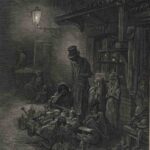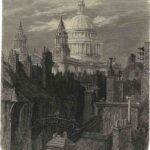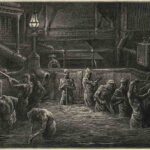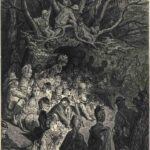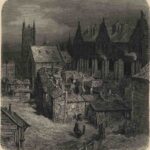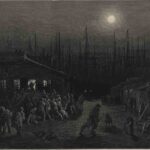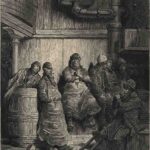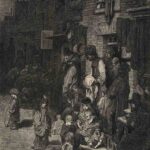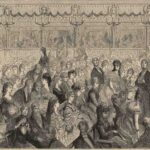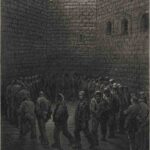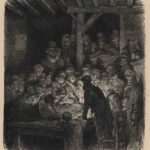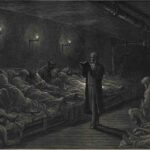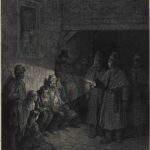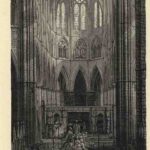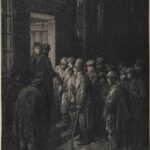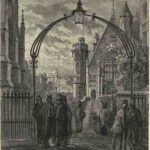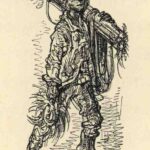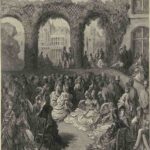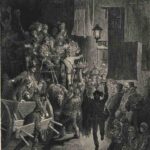Over the course of the month of April, UASC had an opportunity to work with Andrew Moore of Dalhousie University. He was heavily involved in setting up this year’s University Authors exhibit in the link, and has also agreed to be our first guest author on What’s That, UASC?. Andrew Moore is from Saskatchewan, but decided to move 4000 Kilometers away to become a Librarian. An Alumnus of the University of Saskatchewan (B.A 2011), and a current MLIS Candidate (2016) at Dalhousie University, his interests include cooking, reading and history
Introduction
The University of Saskatchewan Archives and Special Collections has a great number of fascinating physical artefacts, historical notes and documents, and rare books. One item of particular interest for both students of social history and rare book enthusiasts is London, A Pilgrimage. Written by William Blanchard Jerrold and with illustrations by the acclaimed illustrator and artist Gustave Doré, it is a sterling example of the emotive, grotesque and sometimes fantastical artwork and text that Victorian audiences were capable of producing, and delighted in consuming.
About the Author
 Despite going by the name of Blanchard Jerrold on the cover of London, the author’s full name was William Blanchard Jerrold (1826-1884). The son of successful Journalist Douglas Jerrold, and godson of poet Samuel Laman Blanchard, for whom he was named, William was educated in both England and France.
Despite going by the name of Blanchard Jerrold on the cover of London, the author’s full name was William Blanchard Jerrold (1826-1884). The son of successful Journalist Douglas Jerrold, and godson of poet Samuel Laman Blanchard, for whom he was named, William was educated in both England and France.
Though Jerrold aspired to be an artist, this dream was derailed when he developed difficulties with his eyesight. He followed in his father’s footsteps and became a journalist; upon his father’s death in 1857 he replaced him as the editor of the newspaper Lloyd’s Weekly. While at Lloyd’s he maintained the liberal political stance of the paper; when the American Civil War broke out, he wrote several articles in favour of the north which were popular enough to be reprinted and circulated in the Continental US.
He published numerous articles over the course of his journalistic career, as well as a number of books. In between times he was also a playwright. Four of his plays were produced and staged in London; the most popular of these, Cool as a Cucumber, played at the Lyceum in 1851.
About the Illustrator
 Gustave Louis Auguste Doré (1832-1883) was born in Strasbourg, France, the second of three children. Doré was something of a prodigy, publishing his first lithographic album at age 15. In spite of his great talent, Doré received minimal formal artistic training, something that would dog his artistic ambitions all his life.
Gustave Louis Auguste Doré (1832-1883) was born in Strasbourg, France, the second of three children. Doré was something of a prodigy, publishing his first lithographic album at age 15. In spite of his great talent, Doré received minimal formal artistic training, something that would dog his artistic ambitions all his life.
Doré was a prolific Illustrator, creating thousands of Illustrations over his lifetime. Many of his earlier Illustrations were comedic caricatures, though Doré was also a tremendous illustrator of serious literary works; illustrations by Doré adorn 19th Century printings of authors such as Dante Alighieri, Miguel Cervantes, Honoré de Balzac, William Shakespeare, Victor Hugo and Edgar Allan Poe, as well as many others.
Despite many of Dorés contemporaries characterizing him as a personality that filled whatever room he entered into, other aspects of Dorés life were not as successful as his prodigious, productive and commercially successful illustrating career; despite being widely circulated in both England and France, his attempts at gaining recognition in other, more critically serious art-forms such as painting or sculpture were generally panned by the French critics. While he was both commercially successful and tremendously popular in England (To the point that he had a museum in London dedicated to his work that remained open well into the early 20th Century), the artistic recognition that he craved was never given to him in his native France during his own lifetime.
Further, Doré was unlucky in the arena of love; despite being romantically interested in several women over his lifetime, Doré remained a perpetual bachelor. Biographers of Doré, as well as some of his contemporaries attribute this to the exceedingly close relationship that Doré had to his mother, who doted upon him, and may have actively thwarted his attempts at romance.
History of the Book
The story behind the physical text of London, A Pilgrimage begins in 1855, when Jerrold and Doré met and became friends. Jerrold had the idea to make a book similar in form to the earlier 19th Century work The Microcosm of London: Or, London in Miniature By Rudolph Ackermann. Jerrold broached the matter with Doré, who at length signed a five year contract, which stipulated that Doré and Jerrold would spend three months a year exploring the metropolis together; Doré would provide the illustrations, and Jerrold would provide accompanying text. For his services, Doré received the incredible sum of £10,000 per year.
Thus contracted, the two began their exploration of London together, exploring garden parties of the well-to-do, the bustling streets of London and industrial gas-works such as those at Lambeth. In their travels they covered much of the city, even infamous neighbourhoods such as Whitechapel (former home of Jack the Ripper). While often travelling alone, in dangerous neighbourhoods the pair was able to call upon the police force, which provided plainclothes detectives to protect the two, and keep them out of trouble.
By 1872, the pair had completed the book, which was published in four parts, and later collected into a single volume. The book was immensely popular, reprinted numerous times, and a great commercial success for the pair.
Despite its financial successes, London’s critical legacy is far more mixed. Modern critics tend to focus on the fact that Jerrold’s text is uneven and bland, and that Dorés illustrations tend towards the fantastical instead of the realistic. Critics of the day said much the same, though they also accused Doré of outright fabrication of details and scenes, and suggested that both Doré and Jerrold were so focused on the most extreme examples of poverty and wealth in London that they failed to represent the middle class, and show an unrepresentative sample of what London really looked like at the time.
These criticisms come, at least in part, from Doré s artistic method. Doré disliked doing work outside of his studio, and so much of the artistic work in London began as a brief sketch, which was then returned to the studio and completed there some hours later. Doré relied on the power of his prodigious memory to retain the details; while his memory was tremendous, it was by no means perfect.
Due to the commercial success of the collaboration between Doré and Jerrold, the two were in the early stages of planning a sister volume to London, which would have focused on the city of Paris. This collaboration never materialized, due to the death of Doré in 1883, at the age of 51.
Gallery
Sources
British Library (2014). London illustrations by Gustave Doré. The British Library. Retrieved from
http://www.bl.uk/collection-items/london-illustrations-by-gustave-dor
Kerr, D. (2004). Doré, (Louis Auguste) Gustave (1832–1883). Oxford Dictionary of National Bibliography.
Retrieved from http://www.oxforddnb.com/view/article/67162
Richardson, J. (1980). Gustave Doré- A biography. Cassell:London
Slater, M. (2004). Jerrold, (William) Blanchard (1826-1884). Oxford Dictionary of National Bibliography.
Retrieved from http://www.oxforddnb.com/view/article/14790.

